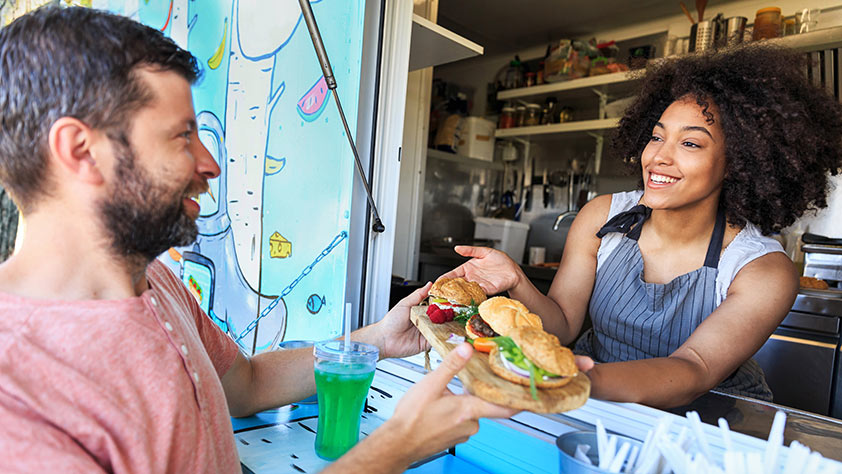When you’re in a place that’s foreign to you, whether you’re in the United States or in another country, figuring out where to eat can be overwhelming. Many travelers rely on sites and apps such as Yelp, Zomato and OpenTable to locate restaurants on the road, but they don’t necessarily help you find all the options that are both tasty and inexpensive.
We asked three savvy travel pros to share some lesser-known tactics to help you find great meals on the road that won’t take a bite out of your vacation budget.
Get dining advice from the most knowledgeable sources
Travel blogger “Johnny Jet” DiScala asks friends and followers on Facebook and Twitter where he should eat when traveling to a new city. DiScala also recommends posing the question on Trippy.com, an online travel community.
Once you’re on the ground, go to the local tourist office and ask for their recommendations and coupon booklets, suggests Matthew Kepnes, founder of Nomadic Matt’s Travel Site.
He also advocates for asking taxi drivers where they eat. “Don’t ask what they recommend,” Kepnes says. “Ask where they go, and they’ll tell you cheaper spots, especially restaurants [with varied cuisines].”
Pop into a hostel to get budget-friendly recommendations. “Even if you’re not staying at a hostel, go inside and ask them about local markets, cheap restaurants and cafes,” Kepnes suggests. “They’re used to dealing with a clientele looking for that kind of food.”
Look for clues about a restaurant’s popularity
Equally important as asking the right sources is knowing what to look out for. “If you want to eat from a food truck or street stall, especially in foreign countries,” DiScala says, “always look for the longest line. There’s a reason why people are waiting.”
Conversely, spots with short lines might mean the food is not good, or the establishment could have a reputation for being unsanitary.
Likewise, if you’re at the airport, search for restaurants where pilots or flight attendants dine. “They usually know where the best food is, and for cheap,” DiScala says.
Pick your food with your fingers (via apps!)
Erin Huffstetler, a frugal living expert at The Spruce, recommends using RoamingHunger.com to track down the best food trucks and their current location.
About a month before your trip, check with local gift card and discounts purveyors, such as Groupon and LivingSocial, for restaurant deals, recommends Huffstetler, who also buys discounted vouchers from Restaurant.com. To dine out on a dime, NEA members can check the NEA Discount Marketplace (check under “Food & Restaurants” and select “Dining”) for discounted dining certificates from Restaurant.com for eateries in the cities where they’re traveling.
Avoid restaurant dining when possible
Skip the expensive restaurant meal and have a picnic with grocery store finds, DiScala says: “It’s usually much more fun, better food and cheaper.”
It’s also cost-effective to book a hotel room with a fridge. Not only can you stock up on lunch essentials at the grocery store, but you also can bring back restaurant leftovers to make a second meal, Huffstetler says. Or find a vacation rental where you’ll have your own kitchen to store groceries, cook meals and reheat leftovers.
If you do want someone else to cook for you, pick a restaurant that accepts to-go orders. Then take your meal back to your room, which saves you money on drinks and gratuity.
If you’re flying, Kepnes suggests bringing an empty water bottle through security and filling it up at a fountain. Also, bring your own sealed food to minimize expenses, but be careful about items that are considered liquids like yogurt.
Strategize your dining to maximize your dollars
If you’re not willing to skip restaurants altogether, get creative! Eat lunch at a swanky place because the prices are normally lower than at dinner (and it might be easier to score a reservation). Or plan your trip during the city’s Restaurant Week, when you can sometimes eat at nicer restaurants for less money, Kepnes says.
Perhaps the best way to avoid overpriced restaurants is to avoid those near tourist attractions. “Those restaurants are usually double the price and half as good,” Kepnes says. “Walk three blocks away, and then start looking for a place.”
You also may be able to cut costs by choosing certain styles of restaurants, such as family-style or fast casual with counter service, Huffstetler says.
If you’re traveling with your family, consider whether all-inclusive meal plans might be more cost effective for your trip. Sometimes you can pre-pay for meals or purchase a meal plan at places like Disney World and other theme parks, as well as at certain resorts.
Think about what kind of food your children like to eat and whether you might be able to bring along some of their favorite snacks and simple meals to save money on restaurant meals. Always ask if there is a kids’ menu, as it will usually have cheaper prices. Some resorts and hotels even offer free meals for children.
Whatever method you choose, stay true to your lifestyle while traveling. “If you don’t eat at fancy restaurants, don’t feel like you have to just because you’re on the road,” Kepnes says. “Great local food is found inexpensively at markets, street vendors and sidewalk cafes.”












